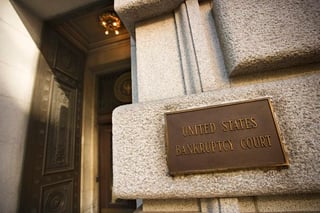 Over the past month, I’ve written about the History of Bankruptcy - from its ancient, biblical origins, through the ancient world and in Europe during the Renaissance period. I’ve paid particular attention to the history of bankruptcy in the United States. I’ve written about the inclusion of bankruptcy in the Constitution as the exclusive legislative prerogative of Congress, and looked at the attempts Congress made to pass a national bankruptcy law in 1800, 1841 and 1867 - all attempts at having an orderly system of bankruptcy in the United States, all eventually politically unpopular and all, eventually, repealed.
Over the past month, I’ve written about the History of Bankruptcy - from its ancient, biblical origins, through the ancient world and in Europe during the Renaissance period. I’ve paid particular attention to the history of bankruptcy in the United States. I’ve written about the inclusion of bankruptcy in the Constitution as the exclusive legislative prerogative of Congress, and looked at the attempts Congress made to pass a national bankruptcy law in 1800, 1841 and 1867 - all attempts at having an orderly system of bankruptcy in the United States, all eventually politically unpopular and all, eventually, repealed.
Then I looked at the Nelson Act of 1898, the first successful attempt by Congress to create a bankruptcy system in the United States, administered by the Federal District Courts. The 1898 law, which lasted in its basic form until 1978, was the product of political compromise between the interests of creditors, represented by the Representatives and Senators from the Northeastern United States, and the interests of debtors, represented in large part by the Representatives and Senators of the Southern and Western United States.
The 1898 law worked, for the most part until the economic crisis of the Great Depression of the late 1920's and 1930's. In 1938, Congress passed, and President Roosevelt signed, a reform act known as the Chandler Act. The Chandler Act unified several amendments to the 1898 law that had been passed during the Great Depression, as well as gave definition to the function of bankruptcy administration in the court system.
The revisions to the law provided for by the Chandler Act made the bankruptcy law workable for another 40 years. But by the late 1960's, the rise of consumer credit transactions, and the resultant increase in consumer credit defaults motivated Congress to take steps to change a law that, when passed in 1898, was largely focused on the issues involved in mercantile and business-related insolvency. In 1970, Congress created a commission to study the current state of bankruptcy law and to make recommendations to Congress for reform of the 1898 law, if appropriate. The commission reported back to Congress in 1973 with several recommendations that I detailed last week.
This week, we’ll look at the competing interests that debated the change in the law that resulted in the Bankruptcy Reform Act of 1978 - the law that replaced a law that had survived for 80 years, and a law that would work to establish bankruptcy as we know it in the United States for another 27 years until this law, too, was revised.
Bankruptcy Judges React
The Commission on United States Bankruptcy Law was composed of bankruptcy professionals and politicians representing many interests. Notable, though, was the exclusion of Bankruptcy Judges from the Commission, and this exclusion led Bankruptcy Judges to make their own recommendation for changes. The Judges opposed the idea of creating a trustee system that was a separate agency of the executive branch, not part of the Federal Judiciary as was then the case. They also opposed the concept of uniform national exemptions, instead proposing "minimum exemptions" that all states would have to adhere to, but allowing states to add exemption protection to certain assets on a state-by-state basis.
The Introduction of Reform Bills
The commission’s recommendations were introduced as a Congressional bill in 1973, but no action was taken on it at that time. But when reintroduced in 1974, the bill started winding its way through hearings in both the House and the Senate. There were numerous hearings in various committees, and subcommittees were formed to study specific aspects of the proposed reform package. As the hearings continued, the lines of division were drawn over several issues. The main issues that were controversial had to do with the status of bankruptcy judges, the concept of nation-wide property exemption and the creation of a bankruptcy administrative agency to handle the non-litigation aspects of bankruptcy administration.
Bankruptcy Judges
One of the critiques of the 1898 law was the lowly status of bankruptcy judges, who were classified as "referees," a status that prevented them from being perceived as having significant authority in adjudicating cases, and who were paid on a case-by-case basis to reduce the administrative cost of bankruptcy and increase dividend payments to creditors. Referees’s decisions could be appealed to the federal district court, so in many cases that were litigated, the referee’s decision was seen as just a little more than advisory in nature; the real adjudication of a dispute between creditors and a debtor would be decided by the district judge. The Bankruptcy Commission proposed to elevate the status of the bankruptcy judges, but the judges themselves were not impressed by the Commission recommendation, since bankruptcy trustees would, under the Commission’s proposal, be removed from their direct supervision and instead become a federal agency independent of the judiciary.
The bankruptcy judges proposed that they be elevated to the same status as federal district court judges - which meant lifetime appointments with a set salary and eliminating the ability of litigants to appeal to their decisions to the federal district courts. Further, the judges proposed that they retain supervision of the trustees.
The Carter Administration opposed the elevation of bankruptcy judges to a status equal to federal district court judges. Instead, the administration proposed that the bankruptcy judges be "adjunct" to the federal district courts.
In the end, a compromise was reached. The bankruptcy judges’s status would be raised so that bankruptcy judges were full-time and salaried, not paid on a case-by-case basis, and the jurisdiction of the bankruptcy courts to decide what were termed "core" proceedings was established authoritatively.
But the bankruptcy judges would be "Article I" judges, not "Article III" judges, so while bankruptcy judges would be appointed by the President (and not the district court judges), their jurisdiction would be confined to "core" proceedings and they would not receive lifetime appointments; rather, bankruptcy judges would serve 14-year terms, subject to reappointment if appropriate. The 14 year terms of bankruptcy judges, would, under the compromise legislation, begin in 1984.
That took care of the judges. But what about the trustees, nationwide exemptions and the under-use of chapter XIII? We’ll look at how those disputes were resolved next week.


